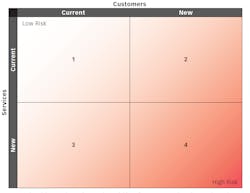The High-Growth Matrix: An easy-to-follow tool for evaluating potential methods for growing your dental practice
COVID-19 has many dentists wondering about the future. Regardless of what occurs—and it is still too early to predict—growing your dental practice is the best way to establish security for yourself and your employees. I’ve written extensively about practice production as the number one success factor that every dentist should focus on and how the right level of production will automatically lead to the right level of revenue, cash, and income—essential factors for a faster, better, and deeper recovery from the COVID-19 crisis.
The purpose of this article is to introduce the High-Growth Matrix. It has been well established and is clearly depicted in the High-Growth Matrix shown in Figure 1, that there are four basic ways to grow any business. Each way has a different contribution to the success of a specific practice and a different level of risk.
What is the High-Growth Matrix?
The High-Growth Matrix is a simple, yet accurate, tool. There are four squares in the High-Growth Matrix and each squareThe second set of variables, “Current” and “New,” is also shown on the outside of the squares. Current customers are active patients who have been in the office within the last 18 months. New customers are patients who have either never been to the practice before, or have not been in during the past 18 months. Current services are services the practice feels comfortable and confident in providing. New services have a learning curve for both the practice and the patients.
Once the external notations are understood, we can look at the inside of the matrix. The squares are marked with numbers 1 through 4. Starting at the top left, or what we call “square 1,” we see the words “Low Risk.” This represents one of the four opportunities to grow the practice with the lowest risk involved. As we move from square 1 to square 4 at the bottom right, we see the words “High Risk,” which means that this option involves the most risk in terms of practice growth. Risk is directly proportional to the numbers. As we move from squares 1 through 4, the risk factor increases.
High-Growth Matrix squares
Square 1: Current services to current customers. Square 1 offers the lowest risk because it’s already happening. However, while it seems as though there is nothing more to be done here, there is still room for growth. Practices often don’t reach their full potential in comprehensive diagnosis, treatment planning, and providing all patients with the services that they need. As practices begin to focus on systems and strategies such as having 98% of all patients scheduled at all times, decreasing no-shows to under 1%, diagnosing all possible hygiene treatment, and promoting and offering elective services, square 1 will begin to expand.
Levin Group target: The Levin Group target for increasing current services to current patients is a 20% increase in practice production.
Square 2: Current services to new patients. The next best and still relatively low risk way to grow your practice is to provide current services to new patients. Naturally, dental practices need new patients and should access different opportunities to increase new patient flow. This can be accomplished through increasing referrals with an internal marketing program focused on education, brand communication, and regular patient outreach. When current patients know that referrals are appreciated, referrals will almost automatically increase. Practices can also add a level of community marketing that creates awareness and offers a free or discounted dental service. The reason this is slightly riskier than square 1 is that new patients don’t yet know the practice and need to develop confidence and trust. However, according to the Levin Group Data Center, new patients offer a 200%-300% higher financial value than current active patients in the first 12 months. Based on risk profile, we recommend all practices focus on growth opportunities in squares 1 and 2.
We also recommend that you carefully track new patients and percentage increase per month and quarter to determine if there is any slowdown in the number of new patients acquired based on the economy and COVID-19.
Levin Group target: The Levin Group target is for the number of new patients to increase anywhere from 3%-10%. This will help compensate for any patients who are lost to the practice due to COVID-19. A strong internal marketing and five-star customer service campaign should accomplish this objective.
Square 3: New services to current customers. This square comes with increased risk, but it’s still relatively low. New services can include new disciplines such as sleep dentistry or more traditional services that weren’t typically offered. The benefit of offering new services to current patients is that they already trust the practice, and there are always patients who automatically accept anything recommended by their dentist. However, there will also be patients who are skeptical of or lack interest in a new service offering, and others who will be interested but take more time to decide.
One of the main challenges of adding any new service is conquering the learning curve. Doctors and teams need time to become familiar with new services, develop efficient systems to support them, and understand the best ways to present treatment options and close cases. This could require a little time, or extensive time. While working on recovering from COVID-19, it does not make sense to add a service that won’t be ready for implementation for 12 to 24 months. We recommend practices focus on short-term opportunities to move through the recovery faster, better, and deeper.
Patients must also become acclimated to a new service. For a new service to gain broad acceptance, it must be accompanied by a patient education campaign. This could take the form of email or telephone updates, electronic newsletters, and patient education during appointments. A patient education campaign will create interest and confidence in the new service.
Levin Group target: The Levin Group target for implementing a new service varies widely. It depends on the service, quantity of patients that can take advantage of the service, fee level, insurance considerations, and the time, recovery, and interest level of patients. The practice should set a production goal for the first 12 months and measure carefully.
Square 4: New services to new customers. This square represents the highest risk because a new service involves a learning and implementation curve, and new patients don’t have the base of trust and confidence that exists with current patients. If a new service is added to a practice, it will most often be available to current patients as well. However, if the new service is used expressly to attract new patients, then the practice will need to determine when the new service will be ready and the best way to communicate this to new patients. There are communication strategies such as providing the information on the practice website and in the welcome packet as well as educating every new patient who calls or visits the practice for the first time. All of this may sound easy, but we rarely see it implemented well. It requires the entire team to be fully prepared and trained for each individual role in communicating this information to a new patient.
Levin Group target: The Levin Group’s recommendation for providing new services to new patients doesn’t have a specific target number. This is an area that is highly dependent on the specific service and how attractive it is to new patients joining the practice.
Summary
The High-Growth Matrix should be used as part of both strategic planning and for answering the question of how to increase practice production. In our experience, most practices can benefit heavily from squares 1 and 2 in the matrix. According to the Levin Group Data Center, practices typically have a 30%-50% growth potential when providing current services to new and current patients. Before moving into riskier areas, it’s better to pursue growth within squares 1 and 2 while determining if new services make sense, then working on mastering the skill sets and the internal systems that they will require.
About the Author
Roger P. Levin, DDS, CEO and Founder of Levin Group
Roger has worked with more than 30,000 practices to increase production. A recognized expert on dental practice management and marketing, he has written 67 books and more than 4,000 articles, and regularly presents seminars in the US and around the world. To contact Dr. Levin or to join the 40,000 dental professionals who receive his Practice Production Tip of the Day, visit levingroup.com or email [email protected].



